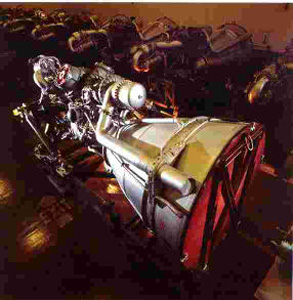Russian Mail-Order Ride
Is the Saturn V’s F-1, first-stage engine more power than you need? Then consider the NK-33, the smaller first-stage engine from the only other moon rocket ever built by the human race.The Soviet N1 lunar rocket, which experienced four failed launches from 1969 to 1972, was a firebreathing behemoth…
Is the Saturn V's F-1, first-stage engine more power than you need? Then consider the NK-33, the smaller first-stage engine from the only other moon rocket ever built by the human race.
The Soviet N1 lunar rocket, which experienced four failed launches from 1969 to 1972, was a firebreathing behemoth belching out 9.666 million pounds of thrust at launch—about three million more than that of the Saturn V—thanks to a cluster of 30 NK-33s that burned, like the F-1, kerosene and liquid oxygen.
The last of those flights was the most successful. It ran smoothly for 106 seconds and reached 25 miles altitude before an oxygen pump explosion triggered disintegration of the rocket.
The NK-33 kicked out 339,000 pounds of thrust, about 125 times its weight.

But with the cancellation of the program, orders came down to destroy the remaining NK-33s. Nikolay Kuznetsov, who headed the Kuznetsov Design Bureau that produced the NK-33 at a plant in Samara, in the Volga region, risked his neck when he disobeyed that order and squirreled away some unused engines in an underground storage locale for more than 20 years. When they reappeared, they were in such good shape that they needed very little updating to become flight ready. Rocketplane Kistler, Aerojet, and Orbital Sciences have been modifying the NK-33 for use in the U.S. market, and talks are afoot for a joint venture to continue producing the little rocket that could.
The Soviet N1 lunar rocket, which experienced four failed launches from 1969 to 1972, was a firebreathing behemoth belching out 9.666 million pounds of thrust at launch—about three million more than that of the Saturn V—thanks to a cluster of 30 NK-33s that burned, like the F-1, kerosene and liquid oxygen.
The last of those flights was the most successful. It ran smoothly for 106 seconds and reached 25 miles altitude before an oxygen pump explosion triggered disintegration of the rocket.
The NK-33 kicked out 339,000 pounds of thrust, about 125 times its weight.

But with the cancellation of the program, orders came down to destroy the remaining NK-33s. Nikolay Kuznetsov, who headed the Kuznetsov Design Bureau that produced the NK-33 at a plant in Samara, in the Volga region, risked his neck when he disobeyed that order and squirreled away some unused engines in an underground storage locale for more than 20 years. When they reappeared, they were in such good shape that they needed very little updating to become flight ready. Rocketplane Kistler, Aerojet, and Orbital Sciences have been modifying the NK-33 for use in the U.S. market, and talks are afoot for a joint venture to continue producing the little rocket that could.